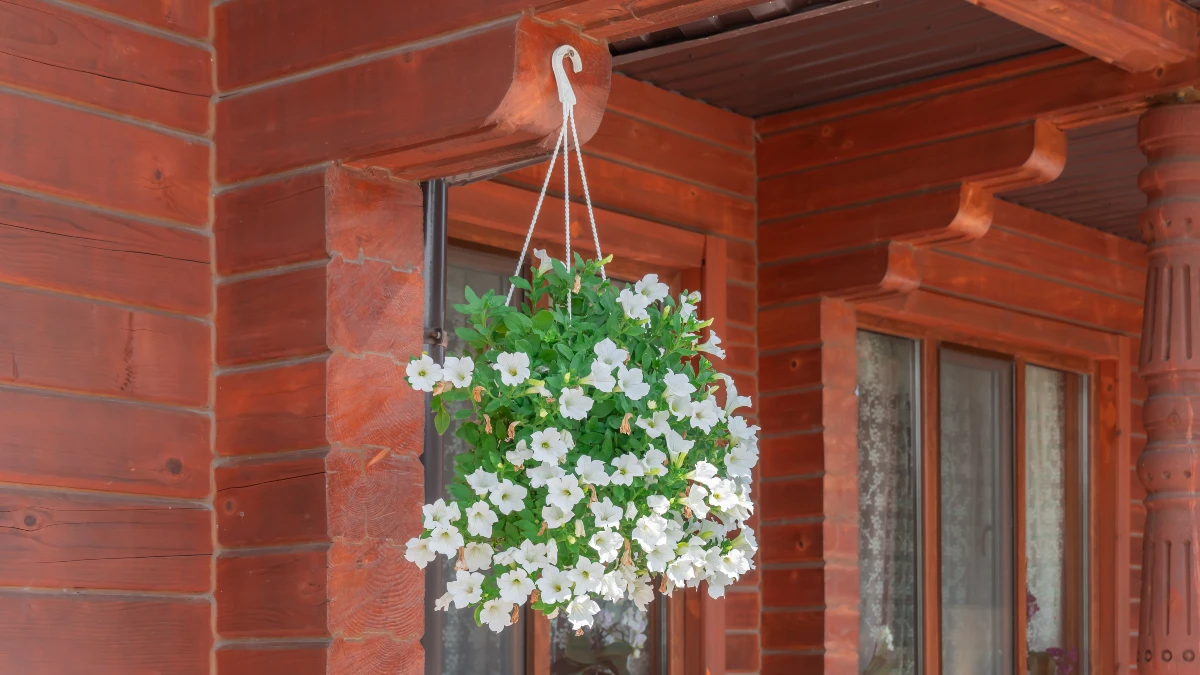Your porch railings and posts are free real estate—vertical color that doesn’t steal floor space. With the right climbing flowers for front porch displays, even a small stoop can carry months of fragrance, blooms, and wildlife interest. The catch? Many vines outgrow tiny spaces, sulk in shade, or fail in pots; a few are invasive, and some are unsafe for pets. We’ll avoid those traps.
In this guide, you’ll learn how to match a vine to your light, USDA zone, and available height; how to choose truly porch-safe species (including native options); how to size containers and select sturdy porch trellis plants that won’t topple in wind; and a dead-simple watering and feeding routine for container vines for porch life.
We’ll clarify light with an extension-standard definition—full sun = 6+ hours of direct sun; part sun/shade = 4–6; shade <2–4—so you can quickly identify the best climbing flowers for shade or sun. And because pots dry fast in heat, we’ll set expectations for summer watering that may be daily—or even twice daily in extreme heat—according to university extension guidance.
Match Plant to Your Porch: Light, Zone & Space
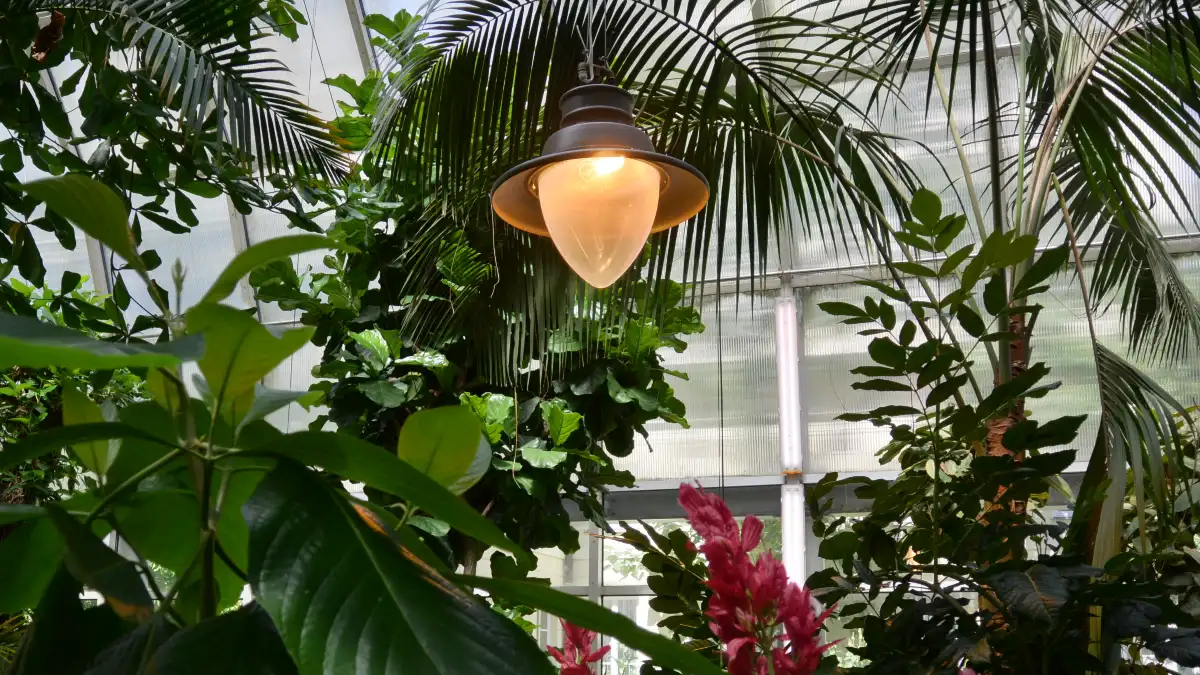
Porch Fit Checklist — Light × Zone × Space
Use this visual to translate your porch conditions into the right vine and support—without guesswork.
Measure your sunlight once → choose a vine that fits
Log one sunny day. Note direct sun on your planting spot each hour. Total it and match the band:
Use your facing to fine-tune plant choices
- South/West → choose sun-loving, heat-tolerant vines.
- North/East → part-shade candidates; protect tender blooms from scorch.
- Windy porches → sturdier trellis + larger container to resist tipping.
Match perennial vines to your minimum winter temps
- Look up your ZIP in the USDA Hardiness Zone Map.
- Note the zone (e.g., 7a) and your neighborhood’s minimum.
- Choose perennials hardy to your zone or colder; use annuals if marginal.
Perennials (clematis, jasmine, honeysuckle, passionflower) need zone match; annuals (e.g., black-eyed Susan vine) are flexible.
| Sun Hours | Good Bets |
|---|---|
| 2–4 h | Shade-tolerant clematis groups; foliage vines + light bloom |
| 4–6 h | Coral honeysuckle, select clematis (cool roots), star jasmine (warm zones) |
| 6+ h | Most bloomers; consider heat-tolerant picks for west-facing porches |
Right-size pot & support for porch success
- Support height = your available space (e.g., 6–8 ft). Pick vines with mature length you can manage.
- Container volume: target ~15–20 gallons for long-term perennials; wider pots = cooler roots & fewer drought failures.
- Thin grab points for clematis: wires/slats they can hook with leaf petioles.
Expert practice: install the trellis/obelisk before planting; anchor to railing or wall to resist wind load.
Swap invasives for porch-friendly natives
| Skip: Chinese/Japanese Wisteria | Choose: American Wisteria |
| Skip: English Ivy on structures | Choose: Coral Honeysuckle or Crossvine |
| Skip: Invasive Honeysuckle (L. japonica) | Choose: Native Coral Honeysuckle (L. sempervirens) |
Check your state’s invasive lists and local extension notes before buying.
Quick Sun-Log Method (15 minutes total)
- Pick a clear day; set phone alarms for 9a, 12p, 3p, 6p.
- At each time, mark “sun” or “shade” for your planting spot.
- Total direct-sun hours → match the Light Ranges above.
- Note wind exposure; windy = heavier pot + extra anchors.
This fast audit mirrors extension definitions and is accurate enough for plant selection.
Start with light. Penn State Extension defines full sun as 6+ hours of direct sun, part sun/shade as 4–6, and shade as <2–4. Use those exact hour ranges to classify your porch now—and choose vines accordingly.
Confirm your USDA zone. The interactive USDA Plant Hardiness Zone Map lets you type your ZIP, then read the zone (and even your neighborhood’s minimums). For perennials (clematis, jasmine, honeysuckle, passionflower), zone-matching is non-negotiable; for annuals (e.g., black-eyed Susan vine) it’s optional but helpful. Screenshot the zone result and keep it in your project notes.
Use porch orientation to refine picks. South and east aspects generally receive gentler, more reliable sun (morning sun is cooler), while west runs hotter and north tends shadier. That means sun-loving, heat-tolerant vines fit south/west; part-shade candidates suit north/east.
Plan for size—even in pots. Container vines still reach real height and mass; budget for their mature length and the width of your support. If you only have 6–8 feet of vertical space, choose moderate selections (certain clematis groups, coral honeysuckle on a short trellis) and avoid ultra-vigorous species that will overwhelm rails and gutters.
Avoid invasives; choose natives or non-invasive alternatives. Popular imports like Chinese or Japanese wisteria are listed as invasive (Tier 2 in Maryland); pick American wisteria or other natives instead. You’ll get porch-scale bloom without ecosystem headaches.
Mini table (fill this after timing your sun):
- 0–2 hrs: Shade vines/foliage accents; mini trellis only
- 2–4 hrs: Part shade candidates; blooms may be lighter
- 4–6 hrs: Part sun stars (some clematis, honeysuckle)
- 6+ hrs: Full-sun bloomers; biggest color potential.
Top Porch-Friendly Climbers (With Sizes & Care)
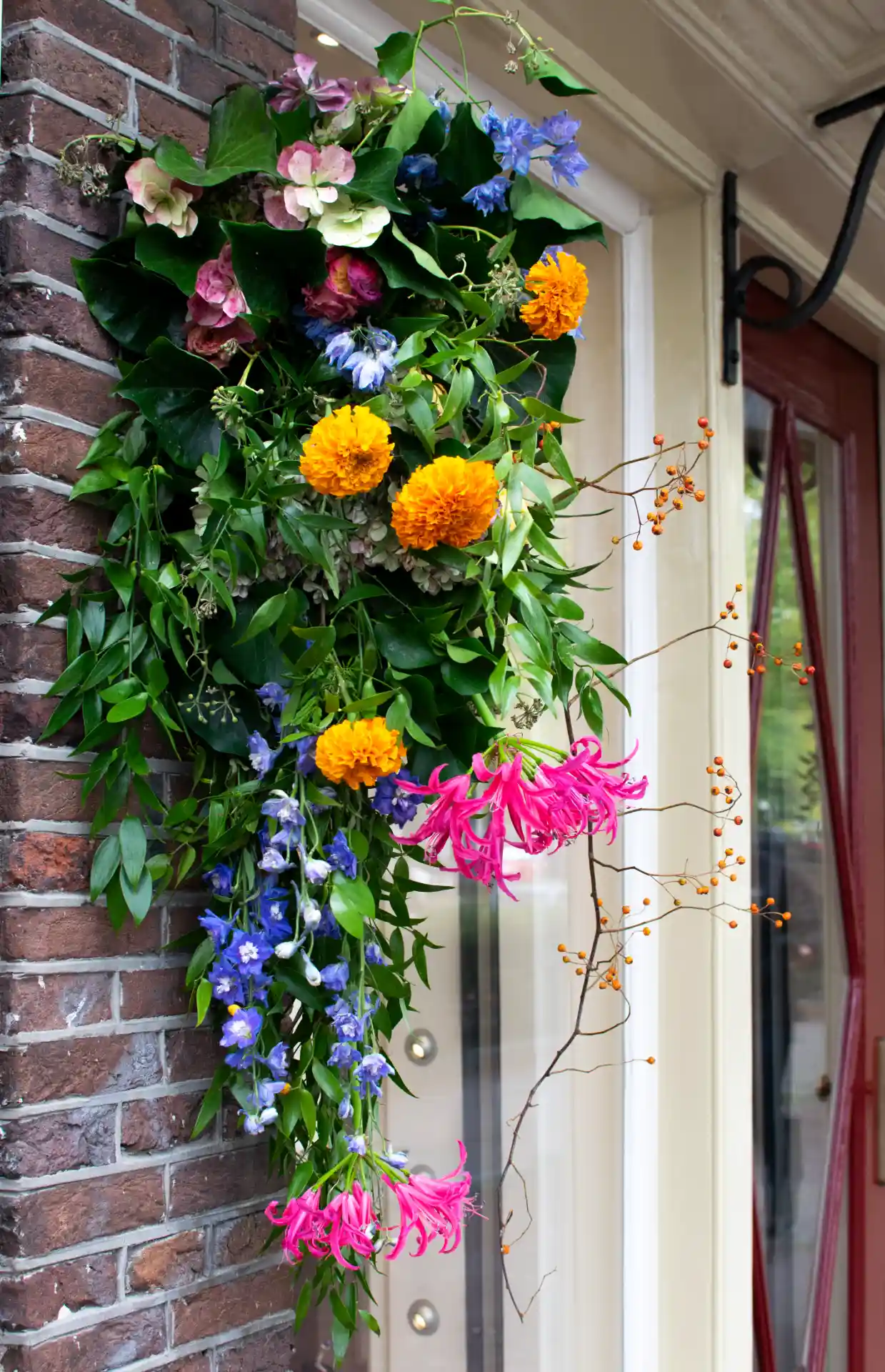
Below are proven climbing flowers for front porch setups that work in containers. Each includes realistic height, light, and porch-specific notes so you can match to space and orientation. (Pet and invasiveness flags included where relevant.)
1) Clematis (hybrids & viticella types) — reliable color, compact supports
- Size & Habit: Common porch types run ~8–12 ft; clematis use leaf petioles to hook onto thin supports (wire/mesh—avoid thick posts alone). Plant crown 1–2 inches below soil; pruning depends on bloom time (Groups 1/2/3). Clemson University’s HGIC offers the gold-standard pruning chart.
- Light: Aim for 6+ hours, but in hot climates give afternoon shade and cool the roots with mulch/neighboring plants.
- Container: For long-term porch culture, think ~18×18×18 in. minimum (≈15–20 gal) so you’re not watering nonstop and roots aren’t cramped. Comparable perennial container guidance (e.g., fruiting vines like grapes) pegs 16–18 in. deep × 18–24 in. wide and 15–20 gal as functional sizes—use that as your clematis benchmark.
- Pet note: Toxic to cats and dogs (protoanemonin). Keep out of reach in pet households. (Consider coral honeysuckle instead.)
2) Star/Confederate Jasmine (Trachelospermum jasminoides) — fragrance + evergreen (warm zones)
- Why it works: Twining stems that climb to ~20 ft on support, glossy evergreen foliage (Zones warm enough), pot-friendly where winters are cold (overwinter inside). North Carolina State University notes: prune after flowering to keep within porch bounds; clean tools—the sap is sticky.
- Best placement: Railings and porch posts near seating (fragrance). Give a sheltered, sunny spot with drainage and a spring feed if native soil/potting mix lacks nutrients.
- Container tip: In cold climates, grow in a lightweight 15–20 gal tub you can hand-truck indoors before hard frost (aligns with large perennial container norms).
3) Coral Honeysuckle (Lonicera sempervirens) — native, hummingbird magnet
- Size & Habit: Typically ~10–20 ft with tubular red/orange blooms on new growth; blooms best in sun. UF/IFAS describes months of pollinator activity and bird-attracting berries later in season.
- Porch fit: Non-invasive alternative to exotic honeysuckles; tidy on a short trellis or wires without overwhelming eaves. For small porches, cap the support at 8–10 ft and tip-prune after the main flush.
- Care: Moderate water once established; train early to avoid tangles at the base. (Clemson also stresses routine pruning for vine health and airflow.)
4) Maypop/Passionflower (Passiflora incarnata) — native exuberance, butterfly host
- Size & Habit: A vigorous twining vine often pushing 15–25 ft in a season under good conditions; hosts Gulf fritillary and other butterflies (NC State Plant Toolbox). Expect summer-to-frost flowers.
- Reality check: This is porch drama—use a sturdy trellis and plan on occasional cutbacks to keep it from swallowing rails. In cold zones, it dies back and returns from the base.
5) Black-eyed Susan vine (Thunbergia alata) — compact, cheerful annual
- Size & Habit: As an annual, commonly 3–8 ft in one season; ideal for small trellises, obelisks, or even hanging baskets with a mini support. Missouri Botanical Garden provides the size range and habit details.
- Feeding: Keep blooms coming by fertilizing every 2–3 weeks during peak season (standard annual-in-container cadence supported by multiple extension sources). Morning sun with afternoon shade is friendlier in intense heat (UF/IFAS regional care notes).
(Warm-zone alternate) Asian/Star Jasmine (Trachelospermum asiaticum)
- Use case: Excellent part-shade groundcover or light climber in warm climates; prune in early spring to reset shape (NC State). On porches, train up wires for an evergreen backdrop beneath seasonal color.
Picker tips:
- Small porch (6–8 ft support): Group-3 clematis; black-eyed Susan vine; compact coral honeysuckle selection.
- Fragrance priority: Star jasmine by seating; consider a lower wattage clematis nearby.
- Pollinators/wildlife: Coral honeysuckle + maypop (native stack).
Right Pot, Right Trellis: Setups That Survive Wind
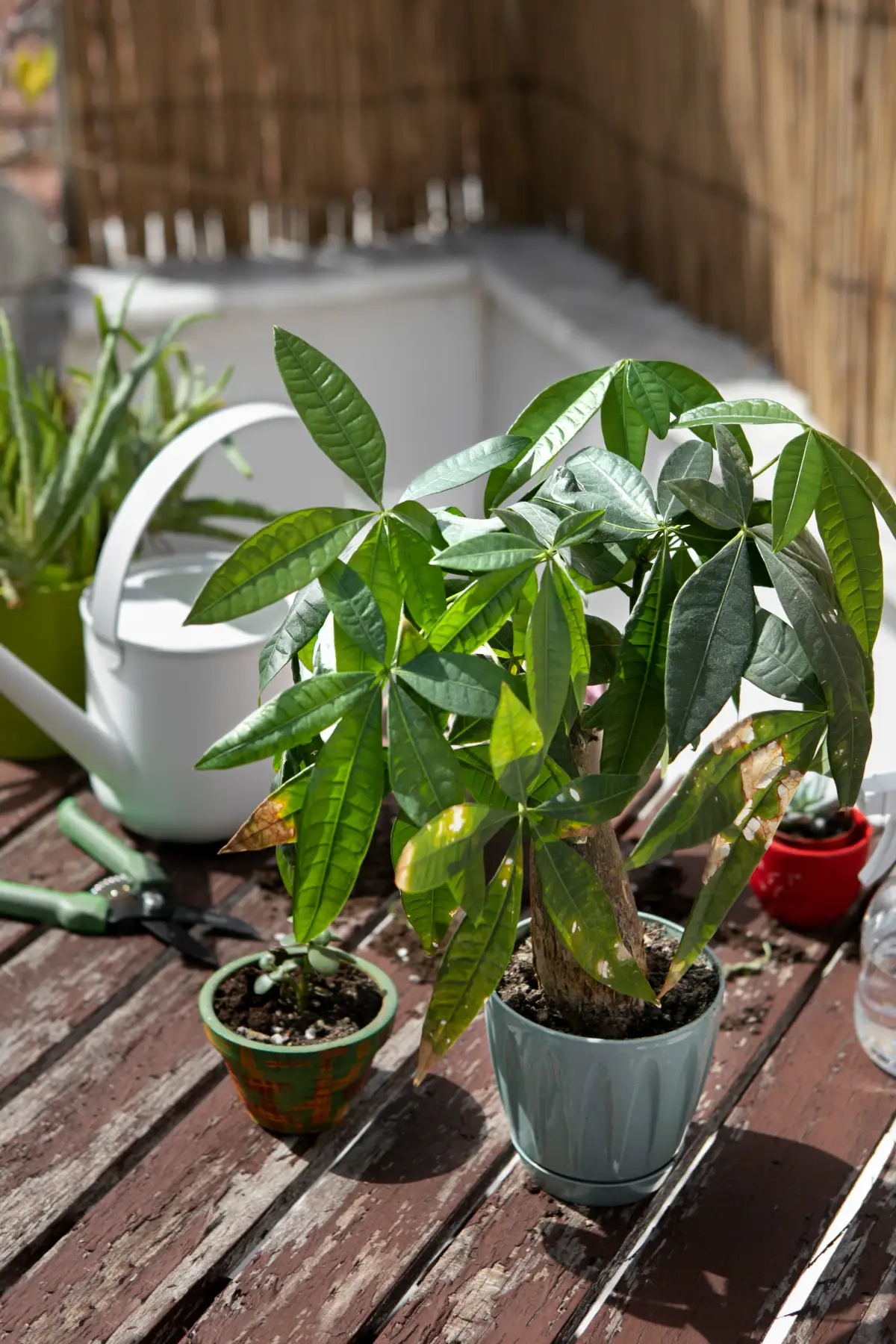
Size the container for staying power. Vining perennials consume water fast; undersized pots tip and dry out. As a practical rule, aim for ~18–24 in. wide and ~15–20 gallons for a long-term porch vine. Michigan State University’s container-grape guidance (a good analog for perennial vine vigor) specifies 16–18 in. deep × 18–24 in. wide and 15–20 gal—a scale that translates well to clematis, honeysuckle, and jasmine grown in pots. Larger volume = cooler roots and fewer drought failures.
Install the support before planting. Illinois Extension is explicit: set the trellis/obelisk first, size it to the vine’s vigor, and anchor it firmly so added foliage mass and gusts don’t topple the container. For clematis, remember they climb by petioles—thin slats or wire are easiest to grasp.
Anchor for wind. On exposed porches, use: (1) a pot-integrated obelisk bolted through the rim; (2) discreet wall/rail ties midway and near the top; and (3) added ballast (paver in the pot’s base, under the liner) if needed. Re-check tightness mid-summer as stems thicken. (These are standard container-vine stability practices derived from extension guidance on scaling supports to plant vigor.)
Skip “drainage rocks.” Washington State University horticulturist Linda Chalker-Scott’s review debunks the gravel-layer myth; it creates a perched water table and worsens drainage. Use pots with large drainage holes and a high-quality soilless mix; if you need weight, place pavers beneath the pot, not inside it.
Checklist (copy into the article):
- Choose a 15–20 gal container (lightweight composite if you’ll move it).
- Insert trellis/obelisk before planting; test for wobble.
- Position where the vine can grow vertically without hitting eaves.
- Fill with soilless mix; plant; add a mulch cap.
- Soft-tie stems every 8–12 inches as they grow; tighten anchors mid-season.
Containers dry out fast—plan for it. In summer heat and wind, container vines can need daily watering—and in extreme stretches twice daily. A quick morning check with your finger 1–2 inches into the mix tells you if it’s time to water. Iowa State University’s Yard & Garden notes that hot, windy days can push baskets and pots to two waterings per day; check at least once each morning and again in late afternoon during heat waves.
University-tested baseline. University of Minnesota Extension advises that, depending on container size and temperature, you may need to water more than once per day to maintain even moisture; a thin mulch cap on the pot reduces evaporation and moderates surface temperature. Water thoroughly until it runs from the drainage holes; don’t let pots sit in saucers of water.
Fertilizer that fits pot-life. Oregon State University Extension recommends a two-part plan tailored to container vines: (1) mix a 3–4 month slow-release fertilizer into fresh potting mix at planting; then (2) supplement every 2–3 weeks with a balanced water-soluble fertilizer through the growing season. This counters nutrient leaching from frequent watering and keeps blooms coming.
Plant-specific note — Black-eyed Susan vine. Wisconsin Horticulture (UW) calls for feeding every 2–3 weeks when grown in containers and in bloom—a great rule of thumb for other heavy-flowering annual vines, too. Morning sun with afternoon shade helps in heat.
Copy-this schedule (May–Sept):
- AM: Moisture check to knuckle depth; water to drain if dry.
- PM (heat waves): Re-check; water again if mix is dry or leaves flag.
- Feeding: Every 2–3 weeks with water-soluble fertilizer; refresh slow-release mid-summer if your season runs long.
Pruning & Season Care (Keep It Tidy, Keep It Blooming)
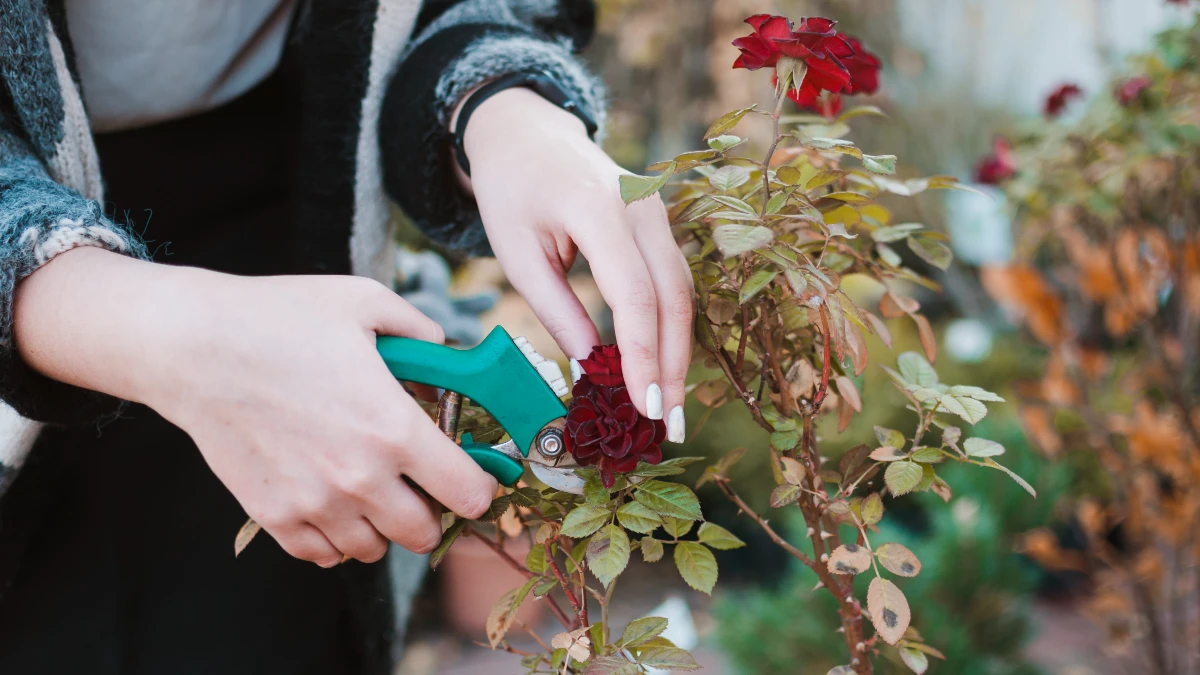
Clematis (Groups 1–3). Clemson University’s HGIC groups clematis by bloom timing, which determines the cut:
- Group 1 (early spring bloomers): Minimal pruning right after flowering—mostly cleanup.
- Group 2 (late spring/early summer + repeats): Light prune in late winter, removing dead/tangled stems; after the first flush, lightly tidy.
- Group 3 (mid-to-late summer on new wood): Hard prune in late winter/early spring to ~12–24 inches, keeping a few healthy buds—this resets size for porch supports and maximizes summer bloom.
Star/Confederate jasmine (Trachelospermum jasminoides). North Carolina State University advises pruning after flowering to keep plants within your porch footprint; clean tools (sap is sticky) and re-tie new shoots to the support.
Maypop (Passiflora incarnata). For porch control, plan a late-winter cutback; many gardeners reduce last year’s stems to the base or a low framework, then re-train spring growth to a sturdy trellis.
Black-eyed Susan vine (Thunbergia alata). For bushier bloom on small trellises, tip-prune long runners and remove spent/faded clusters. The Arkansas Cooperative Extension Service flags spider mites as a common hot-weather issue; avoid drought stress and rinse foliage periodically to discourage mites.
Monthly habit (copy-paste): Late winter shape-up → tie-in new growth in spring → light touch-ups after each bloom flush → mid-summer check for pests, re-tie, and thin congested stems for airflow.
Safety & Sustainability: Pets, Kids, and Invasives
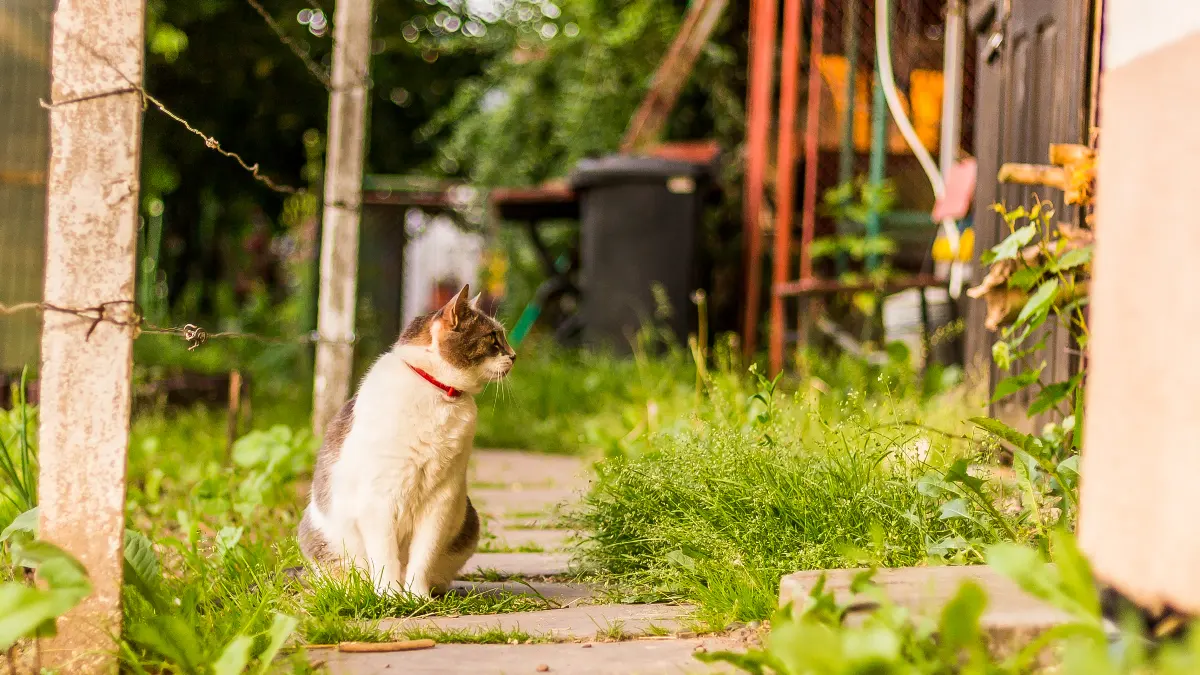
Pet safety—flag these near plant picks.
- Clematis: Toxic to dogs and cats (protoanemonin). Keep out of reach or choose a pet-safer alternative.
- Morning glory (Ipomoea spp.) seeds: contain lysergic alkaloids; ingestion can cause vomiting and, in larger amounts, hallucinations—not ideal for pet-heavy porches.
- Carolina jessamine (Gelsemium sempervirens): High-severity poisonous to people and pets; don’t site it where kids or animals can reach.
Invasives—choose better look-alikes.
- Chinese and Japanese wisteria are listed as Tier 2 invasive in Maryland (retail signage and service restrictions apply) and are flagged as invasive across much of the Southeast. For porch trellises, pick American wisteria or other natives instead.
Seed-law sidebar (why reputable sellers matter).
- The USDA Federal Seed Act and state noxious-weed lists regulate labeling and restrict transport of seed containing noxious-weed seed; buying from reputable sellers helps you avoid unwanted species (and ensures accurate labels for purity/germination). (USDA AMS, Federal Seed Act; State Noxious-Weed Seed Requirements.)
Sustainable habit: default to native, non-invasive vines, secure containers against wind (prevents breakage), mulch pots lightly, and water efficiently in the morning to reduce waste and disease risk.
Conclusion
Porch vines thrive when you match light, USDA zone, and pot size to the plant, give them a stable trellis, and follow a simple routine: water deeply (check daily in heat), feed on a 2–3-week cadence, and prune by bloom time. Choose native or non-invasive options and note pet safety so your display is gorgeous and worry-free all season. This is the most reliable path to long-lasting climbing flowers for front porch plantings—and tidy, resilient porch trellis plants that won’t overwhelm your space.
Try this weekend: use the Quick Picker (light × zone × size), set one 15–20-gallon container with a pre-anchored trellis, and train your first two shoots. You’ll see vertical color fast—and keep it blooming with the routine above.

